Easy Moist Coconut Cake
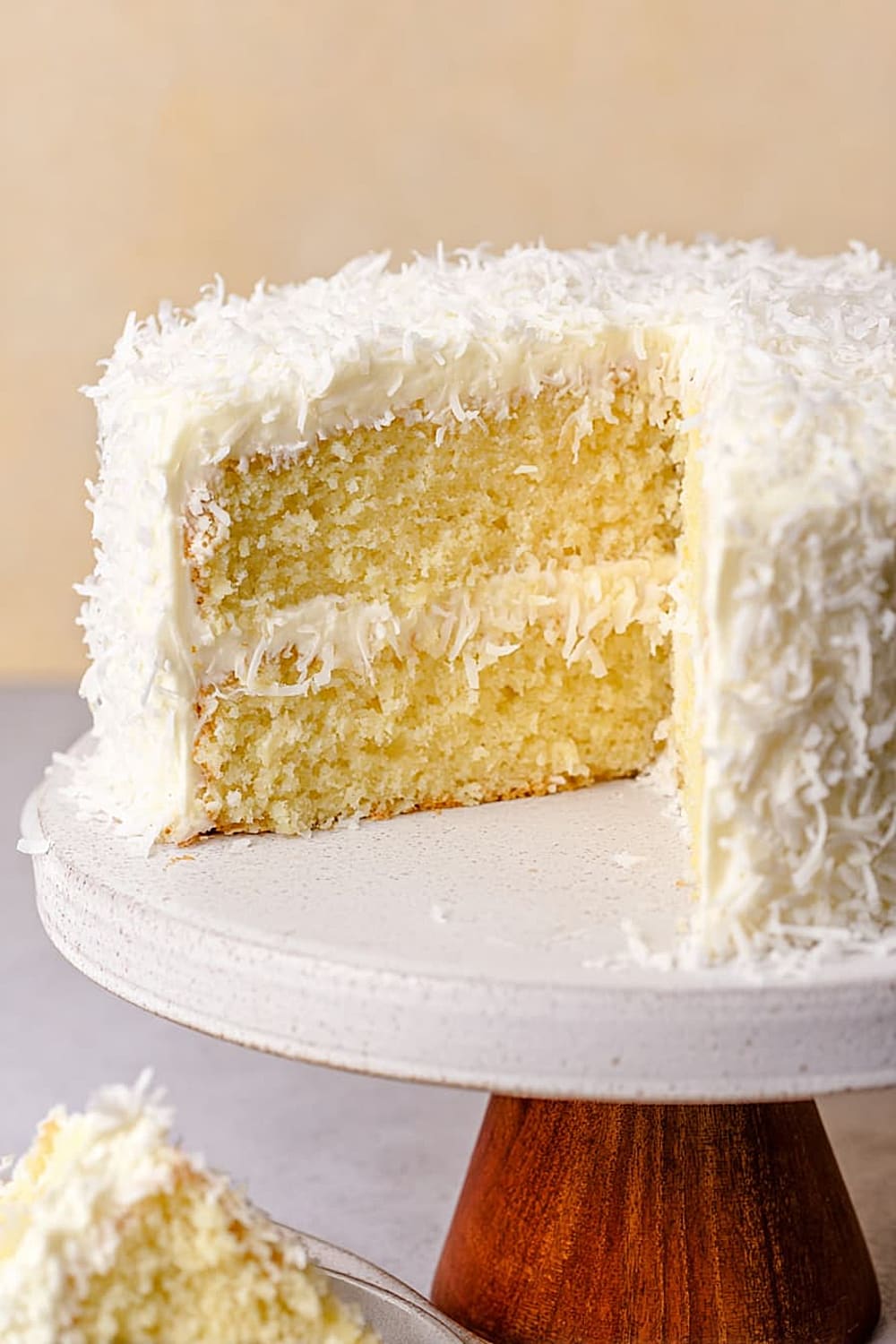
This coconut cake is basically the dessert equivalent of a warm hug from your favorite aunt who always smells like vanilla and has perfectly organized spice cabinets.
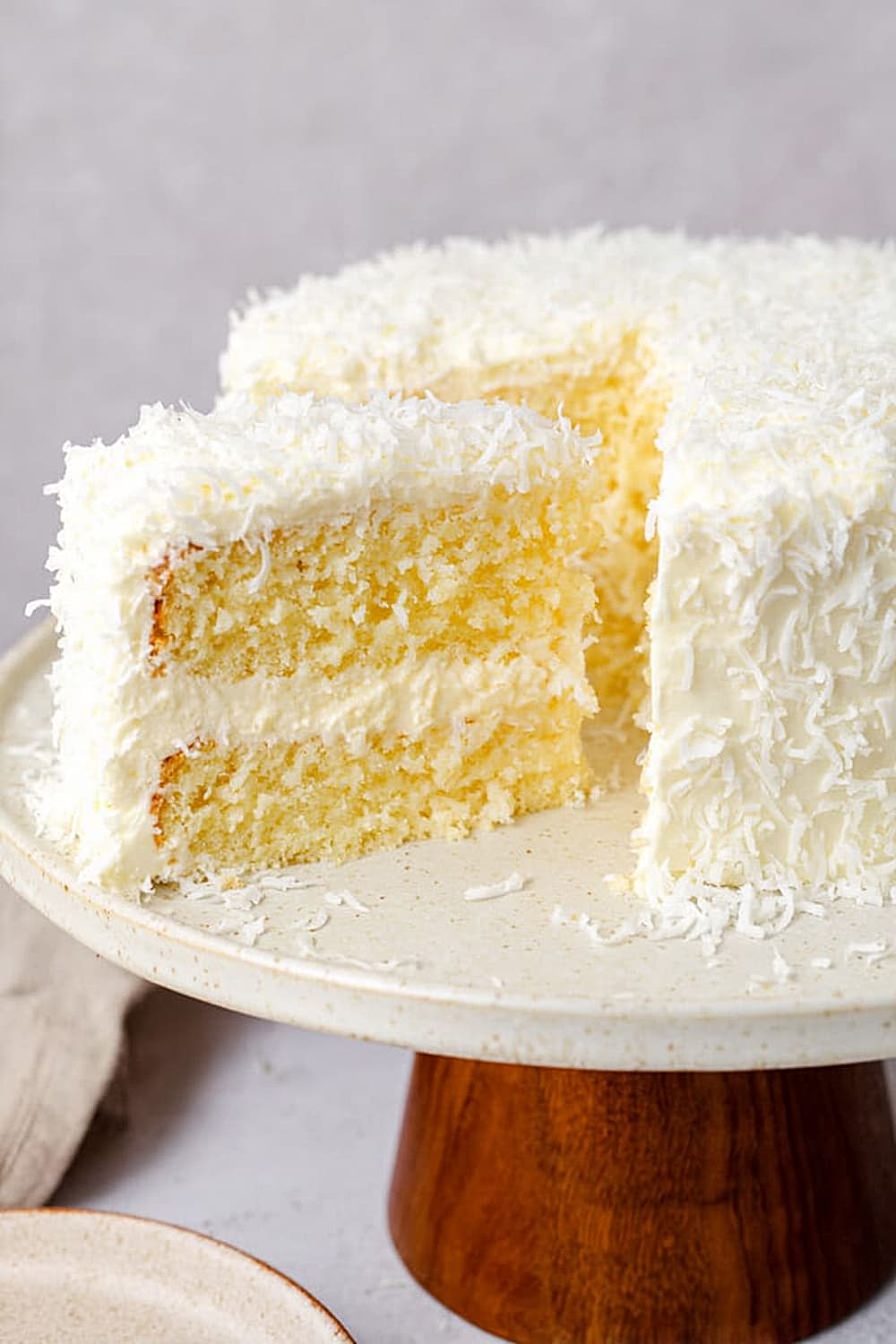
Picture this: tender, fluffy layers that practically melt on your tongue, infused with real coconut milk and topped with the most luxurious cream cheese frosting you’ve ever experienced.
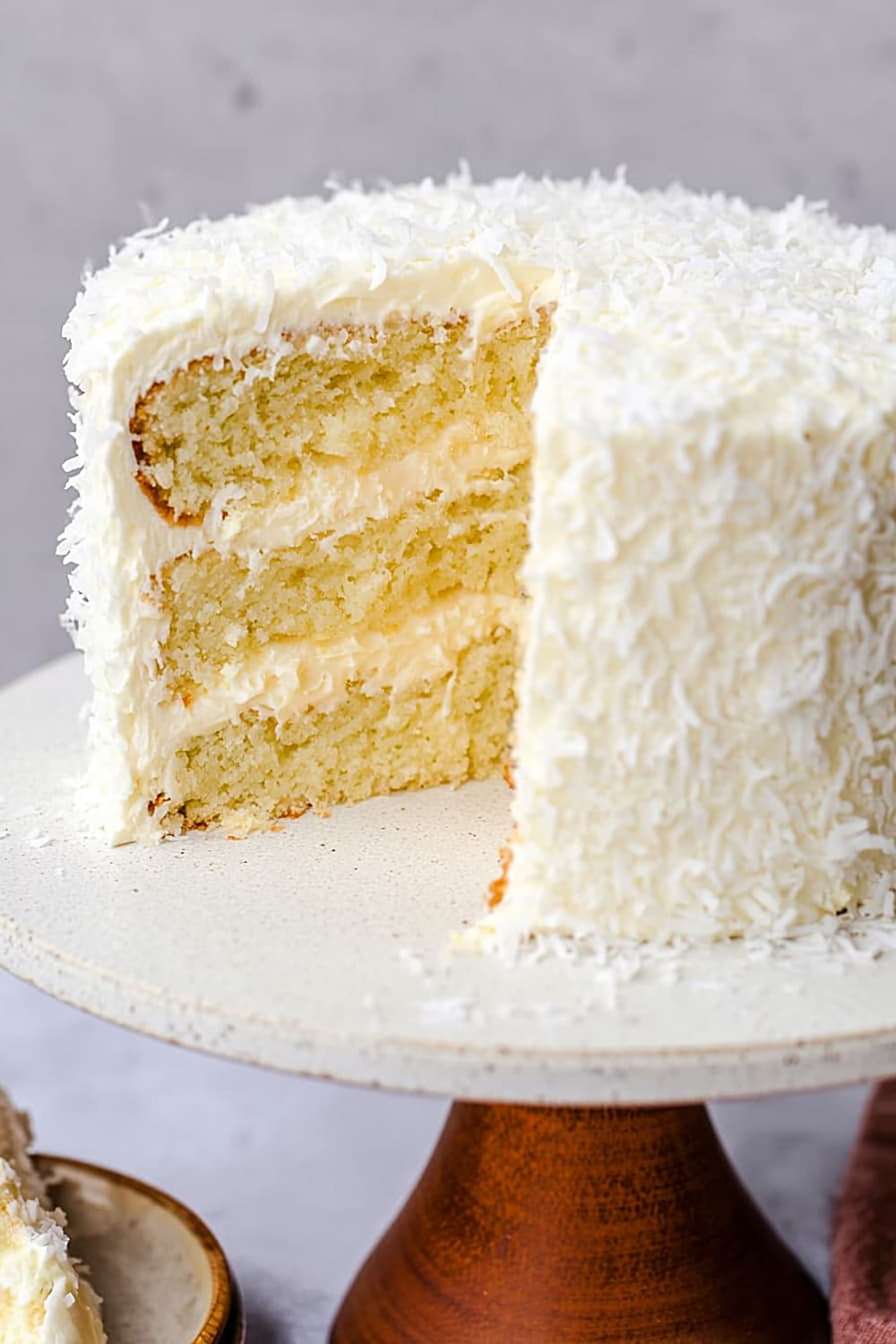
The secret weapon here is using both coconut milk and coconut extract, which creates layers of tropical flavor that’ll make you forget you’re not sitting on a beach somewhere.
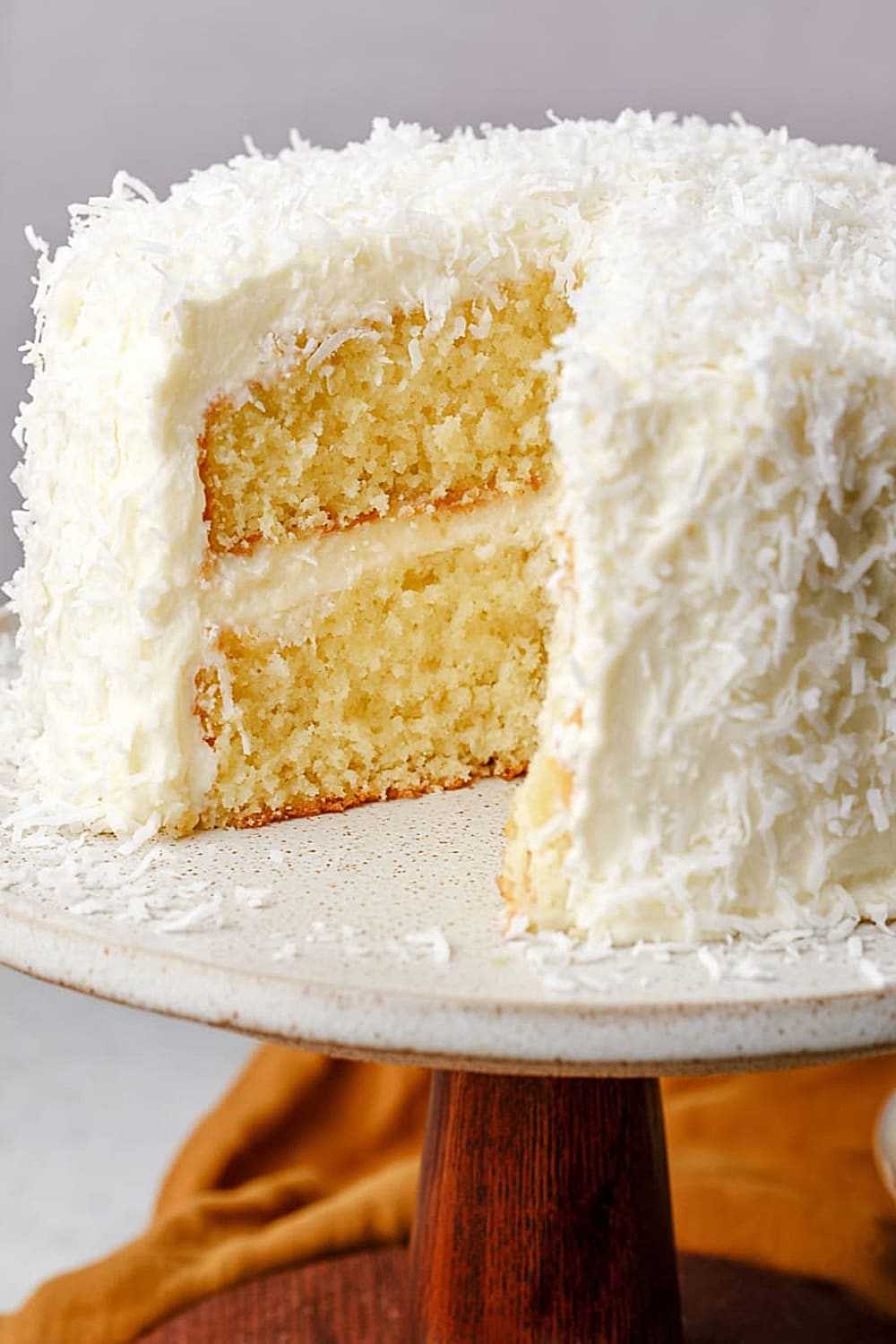
This is the kind of cake that makes people stop mid-conversation and ask “Wait, what IS this?” followed immediately by “Can I have the recipe?”
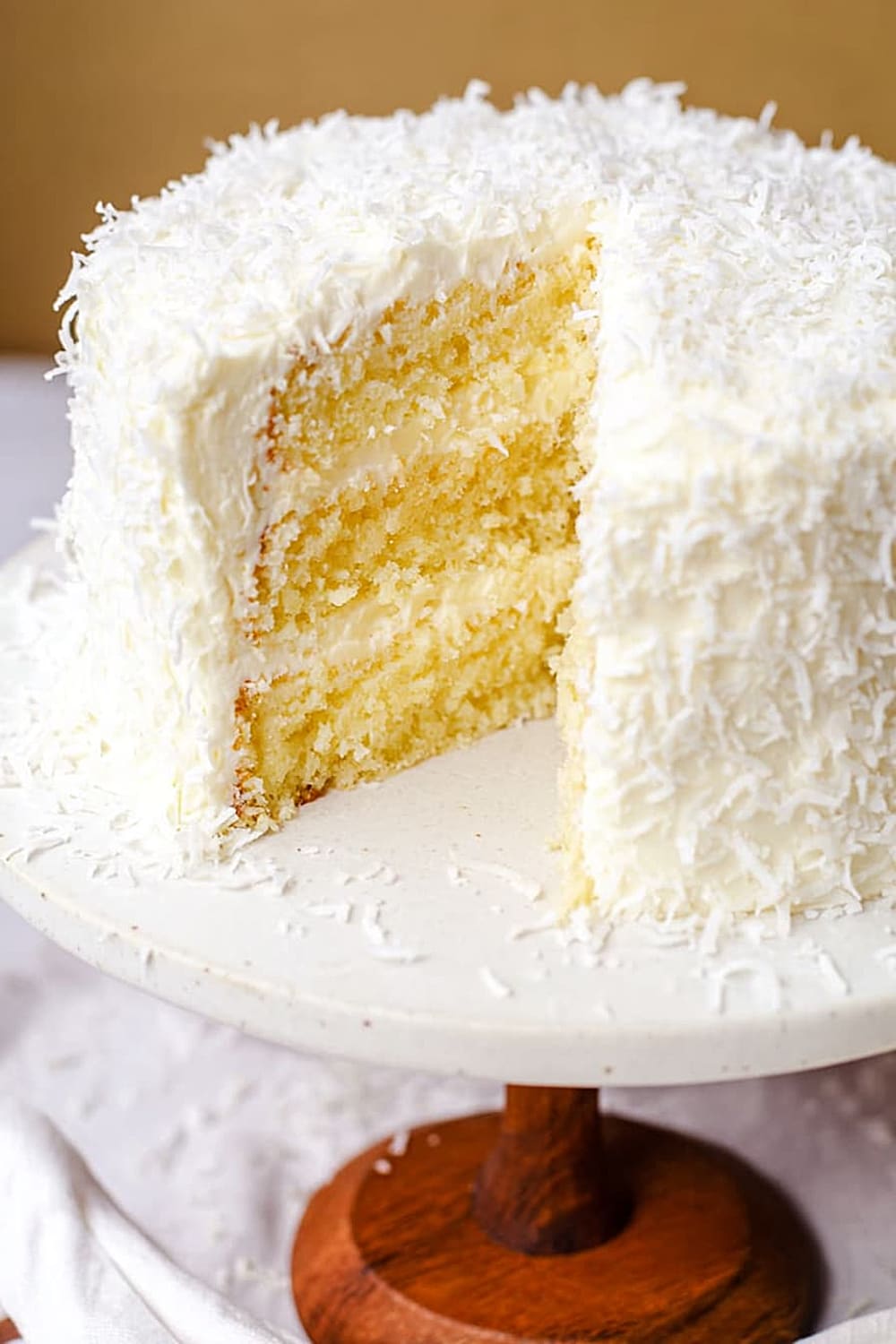
The best part is that despite looking like you spent all day in the kitchen channeling your inner pastry chef, this cake is surprisingly straightforward to make.
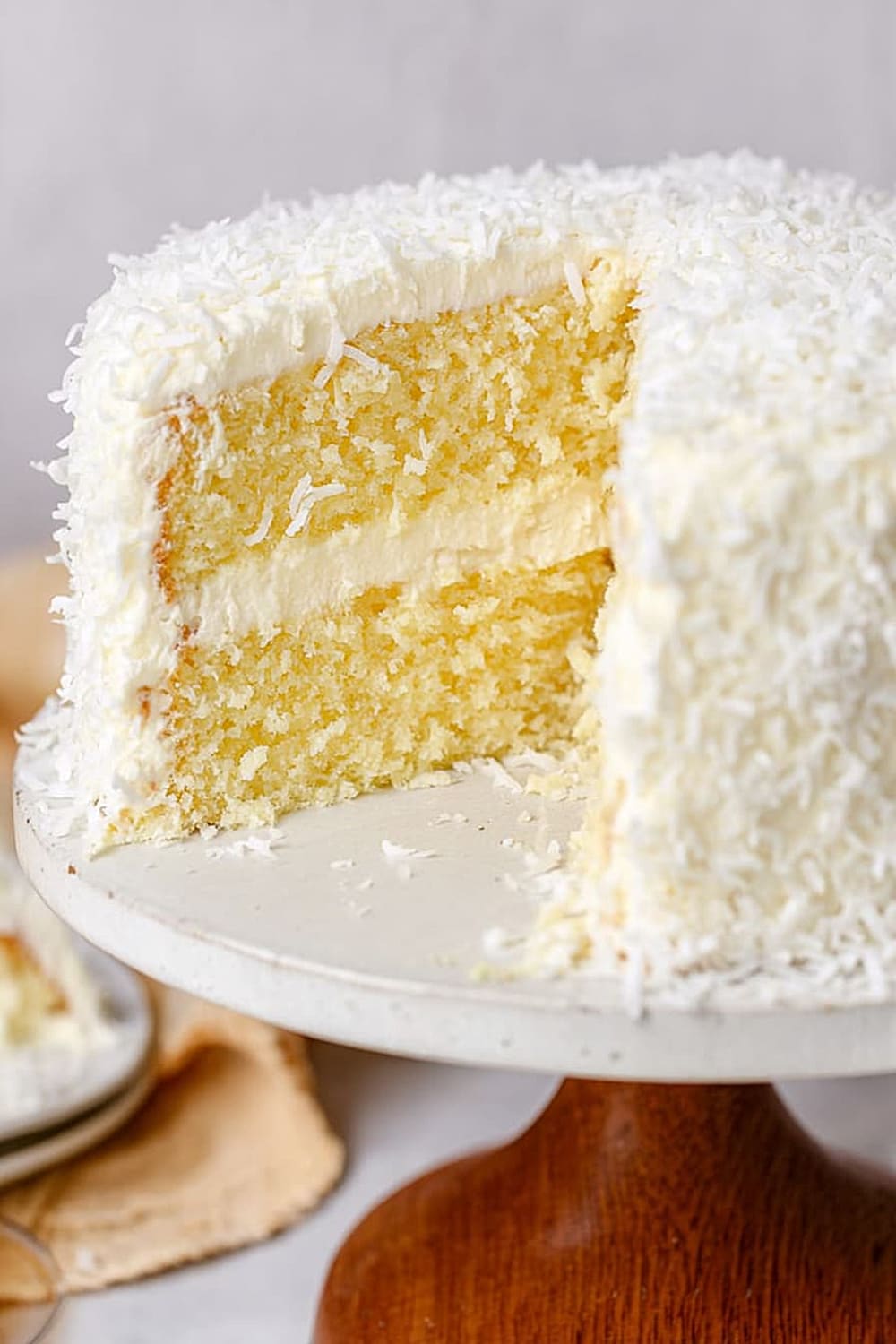
Get ready for your kitchen to smell like a tropical paradise and your reputation as the friend who “makes amazing desserts” to be permanently cemented.
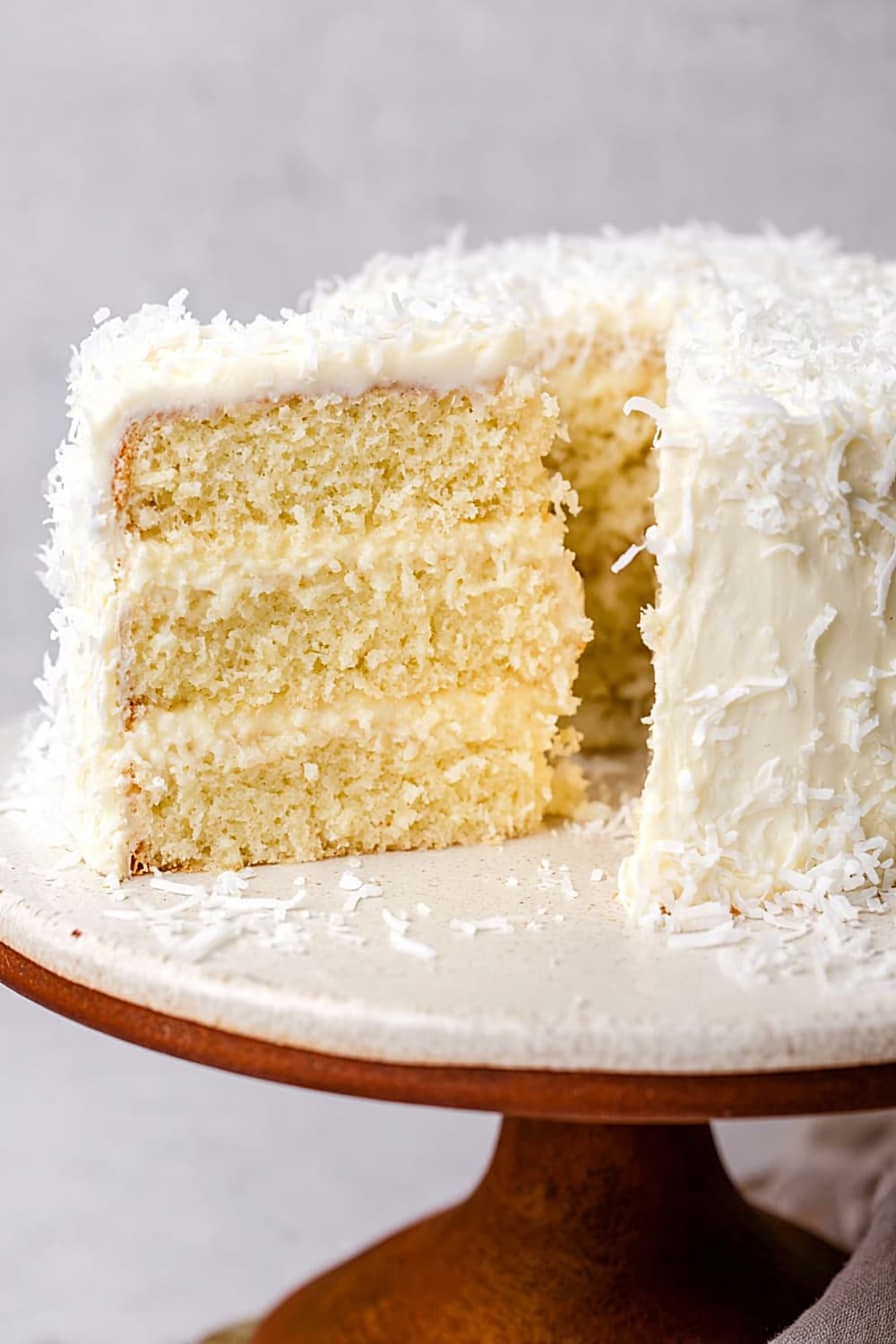
Ingredients
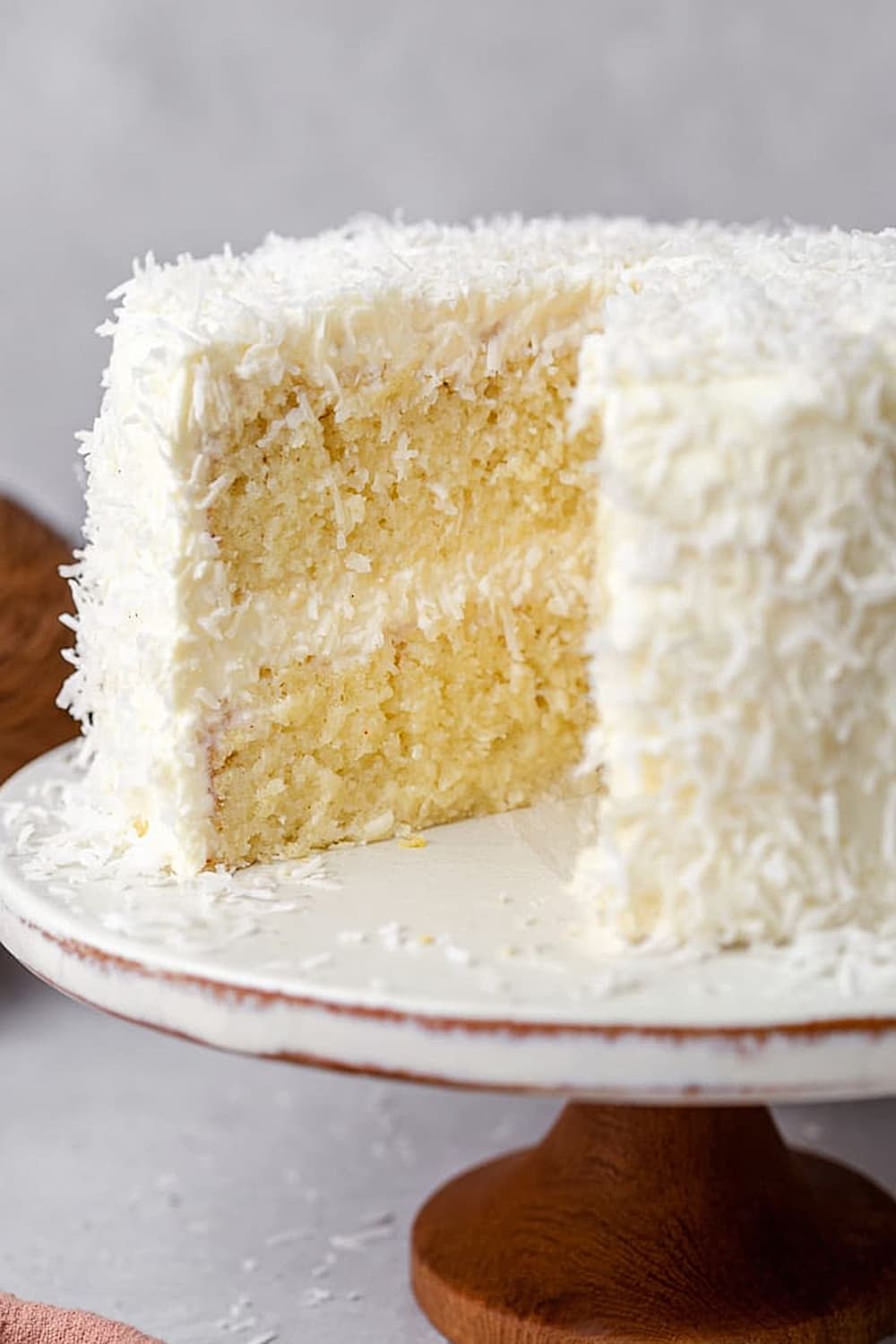
For the coconut cake
- 345 grams (3 cups) cake flour
- 2 teaspoons baking powder
- ½ teaspoon baking soda
- ½ teaspoon fine sea salt
- 226 grams (2 sticks) unsalted butter, softened
- 400 grams (2 cups) granulated sugar
- 2 teaspoons vanilla extract
- 1 teaspoon coconut extract
- 160 grams (about 5 large, ⅔ cup) egg whites
- 180 grams (¾ cup) sour cream
- 170 grams (¾ cup) coconut milk, canned
- 80 grams (1 cup) shredded sweetened coconut
For the coconut cream cheese frosting
- 452 grams (16 ounces) full fat cream cheese, room temperature
- 113 grams (1 stick) unsalted butter, room temperature
- 840 grams (7 cups) powdered sugar
- 2 teaspoons vanilla extract
- 1½ teaspoons coconut extract
- ½ teaspoon kosher salt
- Additional shredded sweetened coconut, for decorating if desired
Instructions
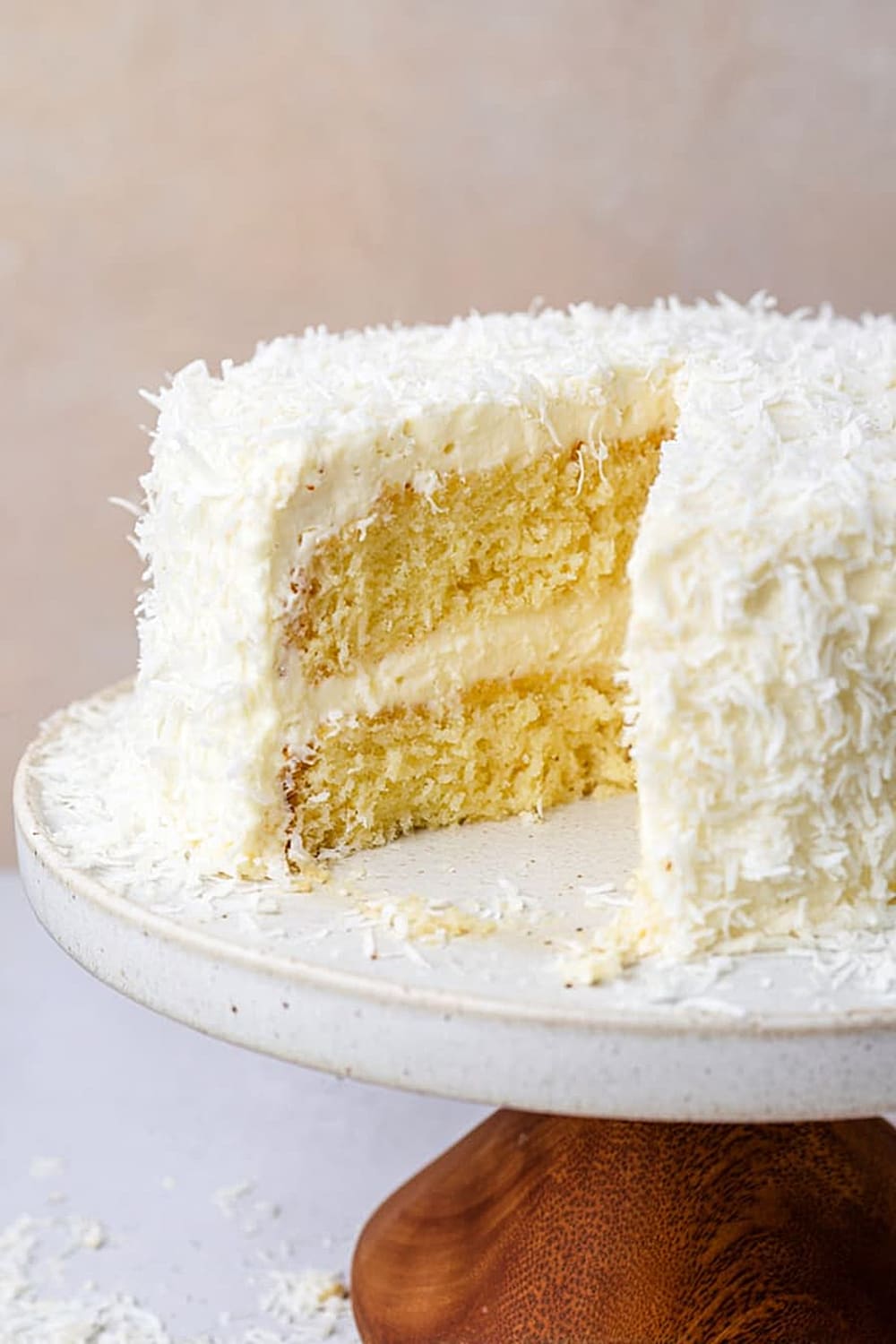
Preparation
- 1 At least 1½ hours before making, take the butter and cream cheese out of the refrigerator to come to room temperature. Cream cheese takes significantly longer than butter to soften properly, so don’t rush this step – cold cream cheese will create lumpy frosting that’s impossible to smooth out.
- 2 Separate the eggs, setting aside the egg whites and saving yolks for another use. Using a kitchen scale for precise measurements will give you the most consistent results. Measure out all remaining ingredients and arrange them in the order you’ll use them.
- 3 Position the oven rack to the center position and preheat to 350°F (175°C). Prepare 2 nine-inch (23 cm) or 3 eight-inch (20 cm) round cake pans by spraying with non-stick spray and lining the bottoms with parchment paper circles for foolproof release.
Make the Cake
- 4 Sift together the cake flour (345 grams), baking powder (2 teaspoons), and baking soda (½ teaspoon) into a large bowl. Add the salt (½ teaspoon) and whisk everything together thoroughly. Sifting creates the incredibly tender crumb that makes this cake special, so don’t skip this step even if it seems fussy.
- 5 In the bowl of a stand mixer fitted with the paddle attachment, or in a large bowl with a hand mixer, combine the softened butter (226 grams) and granulated sugar (400 grams). Cream together on medium speed until very light and fluffy, about 5 minutes. Stop the mixer halfway through and scrape down the sides and bottom of the bowl with a silicone spatula. The mixture should be very pale yellow and noticeably increased in volume when properly creamed.
- 6 With the mixer running on medium-low speed, add the vanilla extract (2 teaspoons) and coconut extract (1 teaspoon). Next, slowly pour in the egg whites (160 grams) while the mixer continues running. Take your time with this step – adding the egg whites too quickly can cause the mixture to curdle. Scrape down the sides of the bowl periodically as you incorporate the egg whites.
- 7 In a measuring cup, whisk together the sour cream (180 grams) and canned coconut milk (170 grams) until smooth. Now comes the crucial alternating technique: add the dry ingredients to the butter mixture in three additions, alternating with the coconut milk mixture in two additions. Start and end with the dry ingredients. Mix on medium speed between each addition until just incorporated – overmixing develops gluten and creates a tough cake.
- 8 Using a silicone spatula, gently fold in the shredded sweetened coconut (80 grams) with smooth, deliberate strokes until evenly distributed throughout the batter.
Bake and Cool
- 9 Divide the batter evenly between the prepared pans and smooth the tops with an offset spatula. Bake for 22-26 minutes, checking for doneness by gently pressing the center – the cake should spring back when lightly touched, and a cake tester inserted in the center should come out clean or with just a few moist crumbs.
- 10 Cool the cakes completely in their pans on a cooling rack before turning them out. This prevents the delicate cake from breaking apart. While the cakes cool, make the frosting – this timing works perfectly.
Make the Frosting
- 11 Place the room temperature cream cheese (452 grams) and butter (113 grams) in the bowl of a stand mixer fitted with a paddle attachment. Mix on medium speed for about 1 minute until smooth, then scrape down the sides with a silicone spatula.
- 12 Add the powdered sugar (840 grams), vanilla extract (2 teaspoons), coconut extract (1½ teaspoons), and salt (½ teaspoon) to the mixing bowl. Start mixing on low speed until the sugar begins to incorporate – this prevents a powdered sugar explosion in your kitchen. Increase speed to medium-high and beat for about 3 minutes until the frosting is light, fluffy, and perfectly smooth.
Assemble the Cake
- 13 If needed, use a serrated knife to trim the tops off the cooled cake layers to create level surfaces. This ensures your finished cake won’t lean or slide.
- 14 Place the first layer on your serving plate and spread a generous amount of frosting evenly across the top using an offset spatula. Add the second layer and press gently to adhere.
- 15 Apply a thin “crumb coat” of frosting all over the cake to seal in any loose crumbs, then add the remaining frosting to cover the outside completely. Use an offset spatula to create smooth sides and top, or use the back of a spoon to create decorative swirls.
- 16 Optional but highly recommended: Press additional shredded sweetened coconut into the frosting all over the cake for extra texture and visual appeal. Refrigerate for at least 30 minutes before serving to set the frosting.
Recommended Equipment and Kitchen Tools
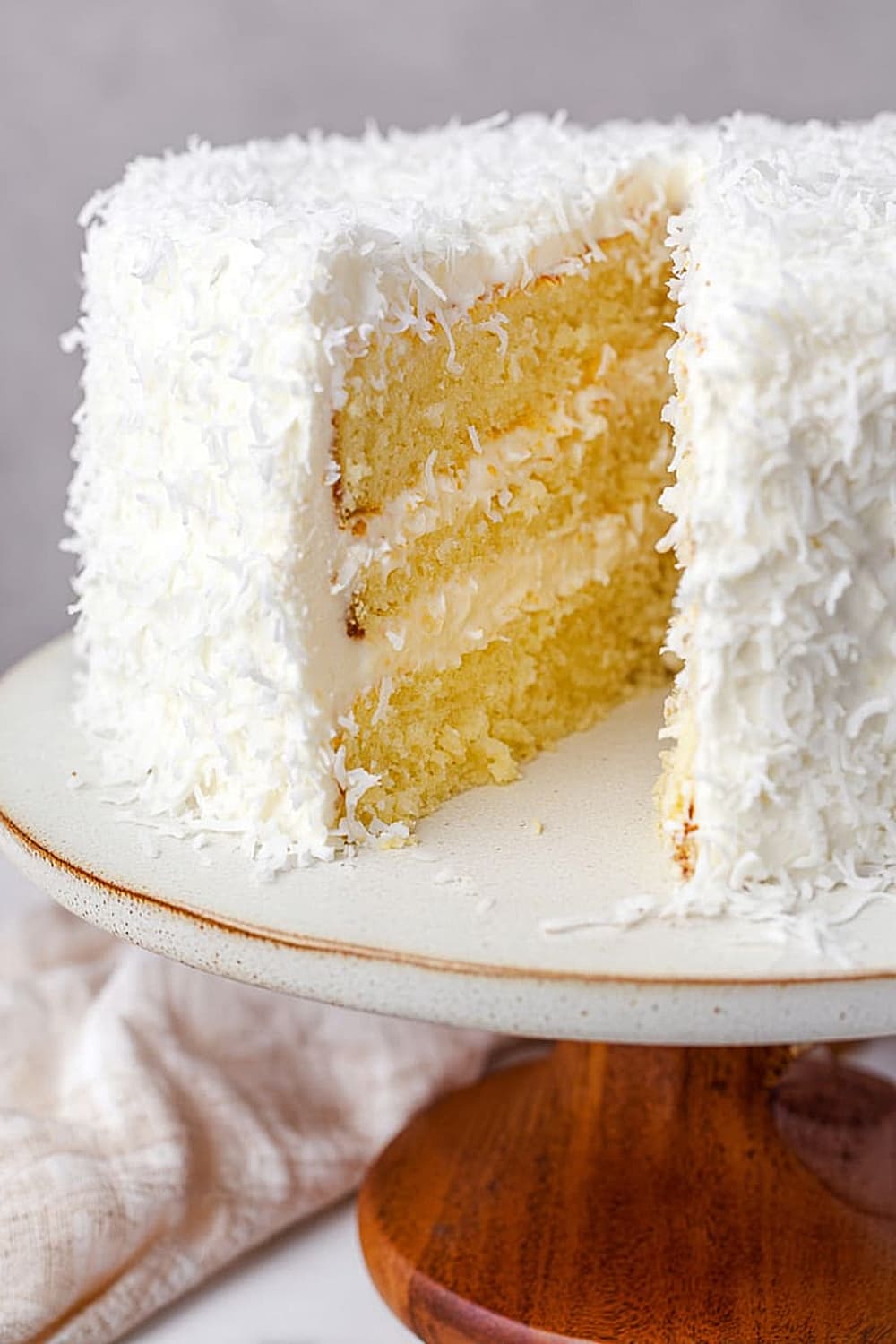
Essential Tools (for best results):
- Stand mixer with paddle attachment – While you can use a hand mixer, a stand mixer makes creaming the butter and sugar to perfect fluffiness much easier and more consistent. The paddle attachment incorporates air better than beaters for this type of cake batter.
- Kitchen scale – Baking by weight rather than volume measurements ensures consistent results every time. Cake flour can vary significantly in density when measured by cups, but grams are always accurate.
- Fine-mesh sieve – Sifting the dry ingredients creates the incredibly tender crumb that sets this cake apart from denser versions. A quality sieve removes lumps and aerates the flour.
- Offset spatula – Essential for spreading frosting smoothly and evenly, plus removing cakes from pans without breaking the delicate layers.
Helpful Upgrades:
- Silicone spatula set – Perfect for scraping down mixer bowls and gently folding in the shredded coconut without deflating the batter. Silicone won’t scratch your stand mixer bowl like wooden spoons can.
- Parchment paper – Pre-cut circles save time and guarantee your cakes will release perfectly from the pans. Professional bakers swear by this simple step.
- Cooling racks – Proper air circulation prevents soggy bottoms and ensures even cooling, which is crucial for layer cakes.
Nice-to-Have Options:
- Bench scraper – Makes smoothing frosting around the sides of the cake much easier and creates professional-looking results.
- Cake turntable – While not necessary, this makes frosting application significantly easier and more even, especially for decorative techniques.
Recipe Variations and Dietary Modifications
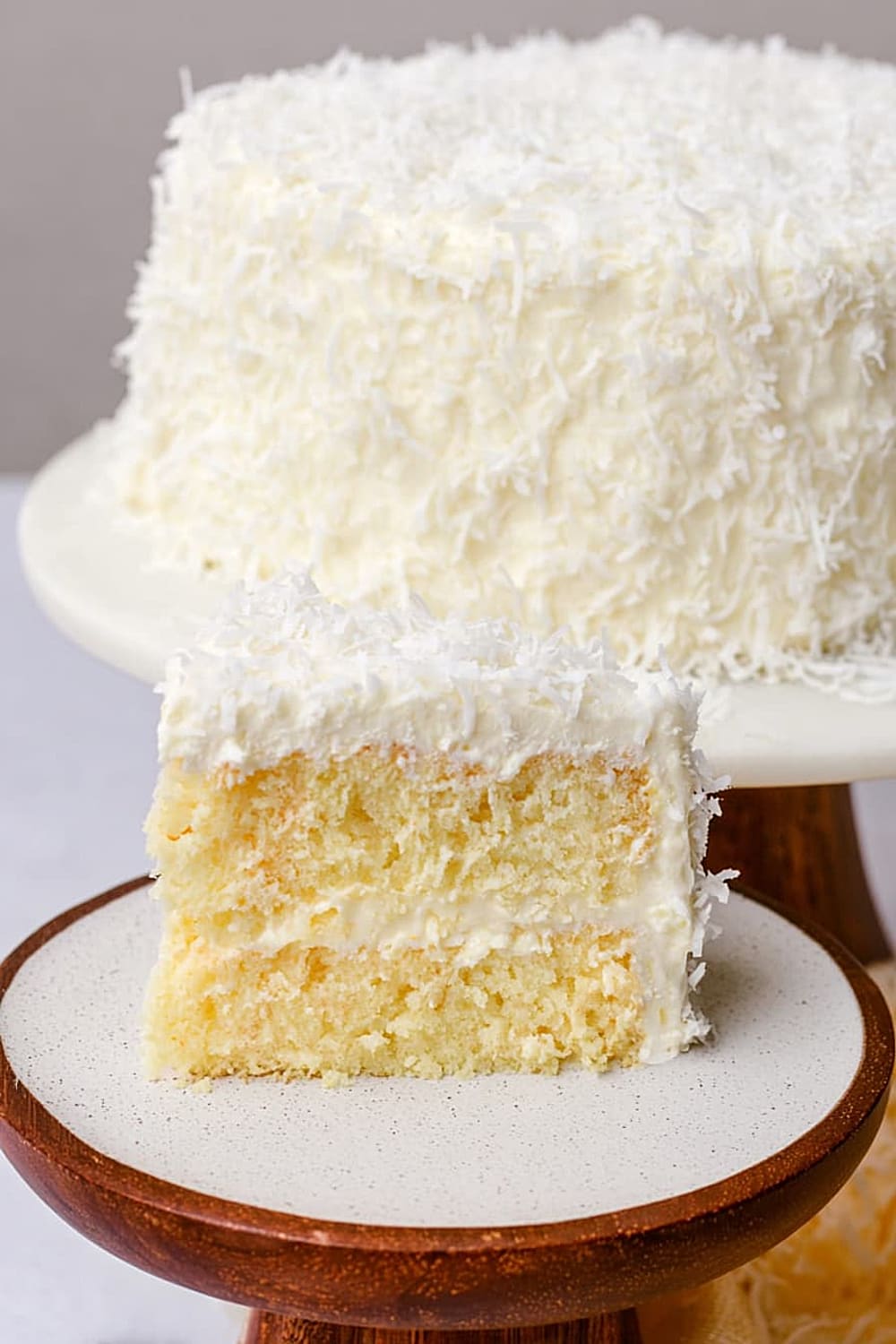
Gluten-Free Adaptation:
- Replace the 345 grams cake flour with 300 grams gluten-free flour blend (one that contains xanthan gum) plus 45 grams almond flour for tenderness
- Add ½ teaspoon xanthan gum if your flour blend doesn’t contain it
- Expect a slightly denser texture but equally delicious flavor
- Increase baking time by 2-3 minutes as gluten-free batters often need slightly longer
Dairy-Free Modifications:
- Substitute vegan butter (like Earth Balance) for both the cake and frosting butter using the same measurements
- Replace sour cream with ¾ cup coconut yogurt or cashew cream
- Use vegan cream cheese for the frosting – Kite Hill or Tofutti work best for stability
- The coconut milk is already dairy-free, so no changes needed there
Flavor Variations:
- Lemon Coconut: Add 2 tablespoons fresh lemon zest to the batter and 1 tablespoon lemon juice to the frosting
- Chocolate Coconut: Replace ½ cup cake flour with ½ cup cocoa powder and add 2 ounces melted dark chocolate to the batter
- Tropical Paradise: Fold in ½ cup diced pineapple (well-drained) and ¼ cup toasted macadamia nuts
- Coconut Lime: Add zest of 2 limes to batter and 2 tablespoons lime juice to frosting for a bright, citrusy twist
Presentation Options:
- Naked Cake Style: Apply frosting only between layers and lightly on top, leaving sides mostly bare for a rustic look
- Cupcake Version: Divide batter among 24 cupcake liners and bake for 18-22 minutes
- Sheet Cake: Bake in a 9×13 inch pan for 28-32 minutes for easier serving at large gatherings
Nutritional Information and Health Benefits
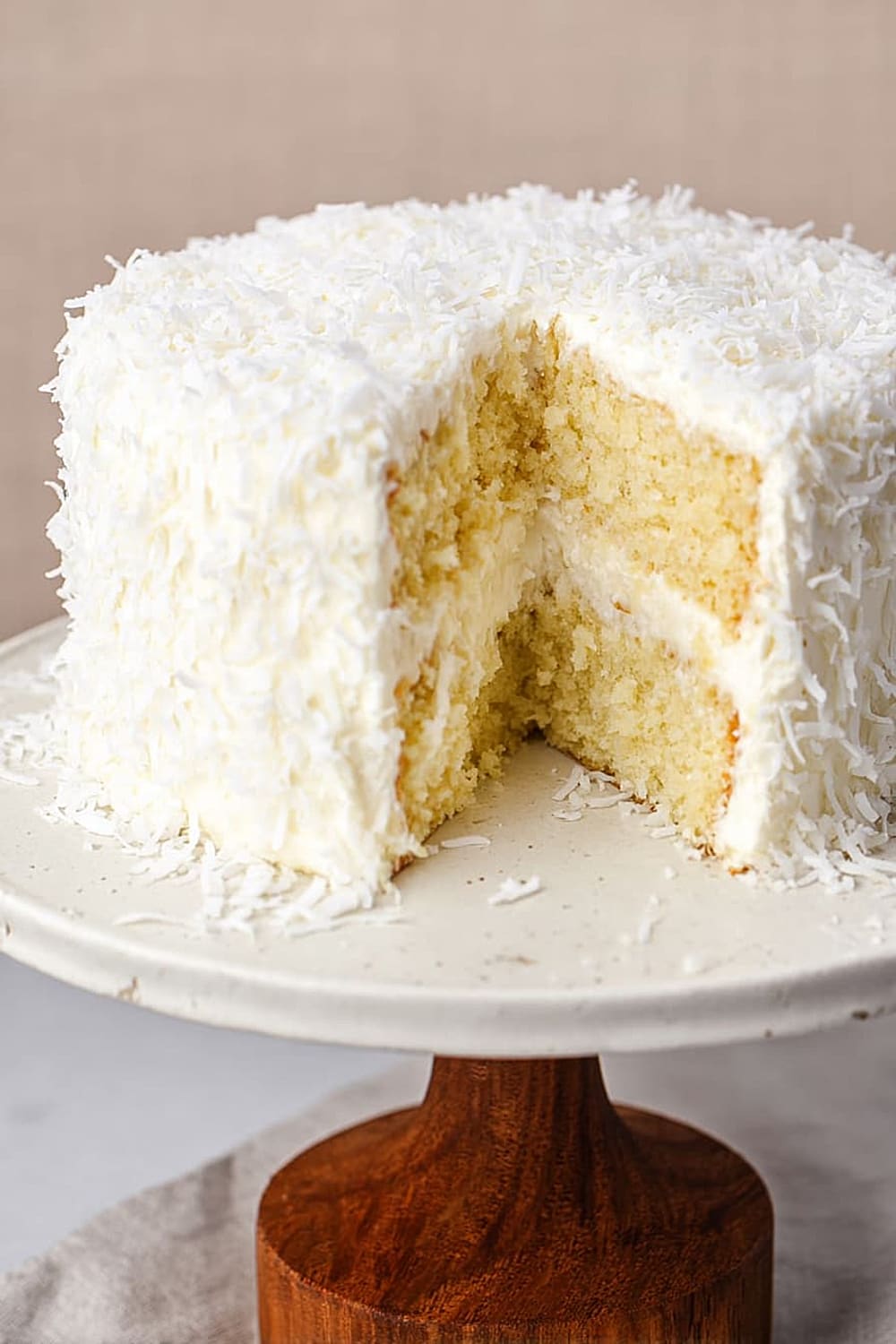
Key Nutritional Highlights:
This coconut cake provides approximately 485 calories per slice (assuming 12 servings), with the majority coming from quality ingredients that offer more than just sweetness. Each serving contains roughly 8 grams protein from the eggs and dairy, 22 grams fat primarily from coconut and butter, and 68 grams carbohydrates. The coconut milk and shredded coconut contribute 4 grams fiber per serving, which helps slow sugar absorption.
Health Benefits of Main Ingredients:
The coconut milk contains medium-chain triglycerides (MCTs), which are metabolized differently than other fats and may support energy production. Coconut provides lauric acid, known for its antimicrobial properties, plus manganese for bone health and metabolism support. The eggs contribute high-quality complete protein and choline for brain function, while cream cheese adds calcium and vitamin A. Even the vanilla extract contains antioxidant compounds, though in small amounts.
Dietary Considerations:
This recipe contains gluten, dairy, and eggs, making it unsuitable for those with celiac disease, lactose intolerance, or egg allergies without modifications. The cake is naturally nut-free unless you choose variations that include nuts. For portion control, consider cutting into 16 smaller slices rather than 12, reducing calories to approximately 365 per serving. The high fat content actually helps with satiety, meaning smaller portions can be quite satisfying.
Smart Swaps and Ingredient Substitutions
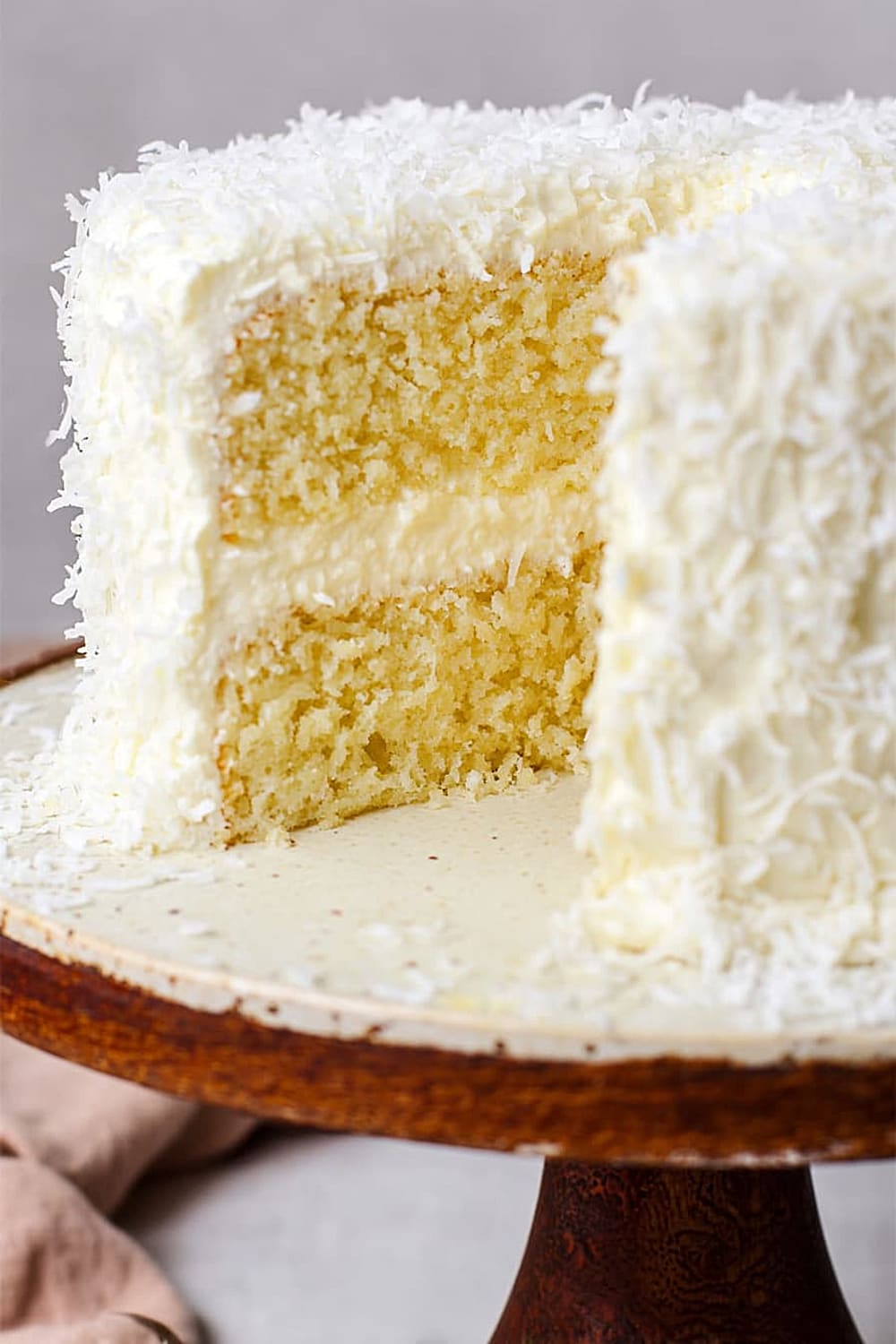
Common Substitutions:
- Cake flour → All-purpose flour minus 2 tablespoons per cup + 2 tablespoons cornstarch per cup (sift together)
- Coconut milk (canned) → Heavy cream or whole milk for less coconut flavor but same richness
- Sour cream → Greek yogurt (same amount) or buttermilk (reduce by 2 tablespoons)
- Coconut extract → Vanilla extract or almond extract if coconut flavor isn’t desired
Budget-Friendly Swaps:
- Cream cheese frosting → Buttercream frosting made with butter, powdered sugar, and milk (costs about 40% less)
- Cake flour → All-purpose flour with cornstarch modification saves money without sacrificing much texture
- Coconut extract → Extra vanilla plus coconut flakes steeped in warm milk, then strained
Pantry Emergency Substitutions:
- Egg whites → 3 whole eggs (cake will be slightly denser but still delicious)
- Baking powder → ¼ teaspoon baking soda + ½ teaspoon cream of tartar per teaspoon needed
- Powdered sugar → Granulated sugar processed in a blender until fine (add 1 tablespoon cornstarch per cup)
Pro Tips for Substitutions:
- Store coconut extract in the refrigerator after opening – it maintains potency longer than vanilla
- When using all-purpose flour instead of cake flour, mix the batter 30 seconds less to prevent toughness
- Room temperature ingredients are crucial – if you forgot to take them out early, place eggs in warm water for 10 minutes and microwave butter for 10-15 seconds
Make It Diabetes-Friendly
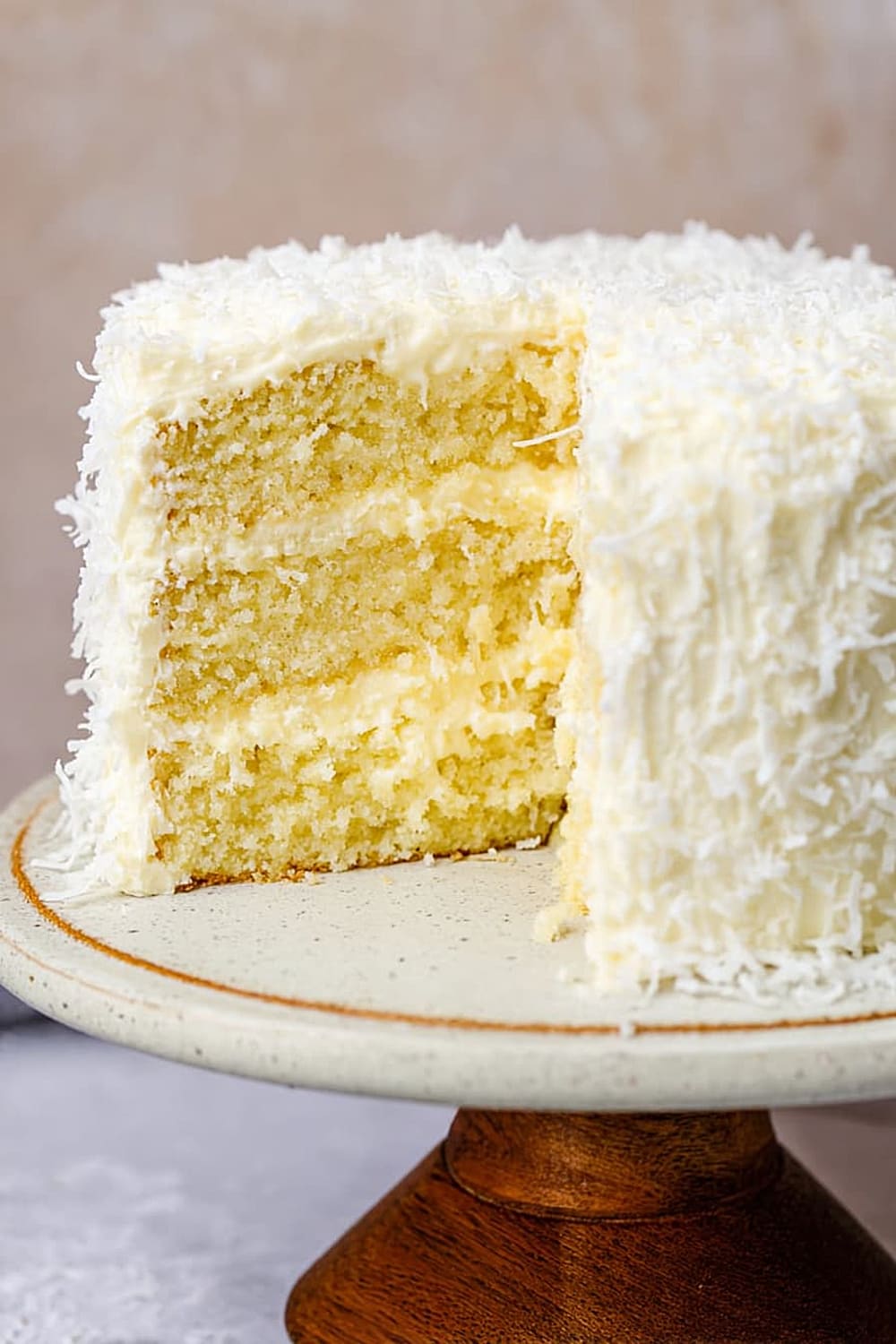
Sugar Substitutions:
- Replace the 400 grams granulated sugar with 200 grams erythritol or 150 grams stevia blend (like Truvia)
- For frosting, substitute 840 grams powdered sugar with 420 grams powdered erythritol
- Monk fruit sweetener works well too – use about ⅓ the amount of the original sugar
- These swaps reduce total carbs by approximately 65-70%
Flour & Carb Modifications:
- Replace 345 grams cake flour with 200 grams almond flour + 145 grams coconut flour
- Add 1 teaspoon xanthan gum to help bind the alternative flours
- This modification reduces net carbs from 68g to about 12g per slice
- Expect a denser, more moist texture that’s actually quite appealing
Portion & Timing Tips:
- Cut into 16 slices instead of 12 for better portion control
- Each modified slice contains approximately 8-10 grams net carbs
- Pair with protein-rich foods like nuts or cheese to further slow glucose response
- Best timing: Enjoy after meals rather than as standalone snacks
Total Carb Reduction: Modified version contains approximately 85% fewer carbs than original recipe while maintaining the essential coconut flavor and celebratory feel.
Perfect Pairing Suggestions

Beverage Pairings:
The rich coconut flavors pair beautifully with coffee-based drinks – try it with a smooth medium roast coffee, cappuccino, or even cold brew for contrast. For wine lovers, a late-harvest Riesling or Moscato complements the tropical notes without competing. Champagne or Prosecco creates an elegant celebration combination, while coconut water or pineapple juice enhances the tropical theme for non-alcoholic options. During colder months, pair with chai tea or golden milk lattes for warming spice notes.
Side Dish Recommendations:
Fresh berries and cream provide acidic brightness that cuts through the rich frosting beautifully. Grilled pineapple or mango slices amplify the tropical theme while adding natural enzymes that aid digestion. For texture contrast, serve alongside toasted coconut flakes, macadamia nuts, or candied ginger. A simple fruit salad with lime juice and mint creates a refreshing palate cleanser between bites.
Complete Meal Ideas:
This cake shines as the finale to seafood dinners – particularly grilled fish, shrimp, or crab dishes where the coconut echoes coastal flavors. It’s perfect after spicy cuisines like Thai, Indian, or Mexican food, as the creamy sweetness soothes heat. For brunch gatherings, serve smaller portions alongside fresh fruit and coffee. Summer barbecues benefit from this cake’s tropical vibe, especially when served with grilled stone fruits.
Occasion Suggestions:
Ideal for spring and summer celebrations – graduations, Mother’s Day, bridal showers, or birthday parties. The elegant appearance makes it suitable for dinner parties, while the approachable flavors work for casual family gatherings. Consider it for tropical-themed events or any time you want to bring sunshine to the table, regardless of weather outside.
Pro Tips and Troubleshooting
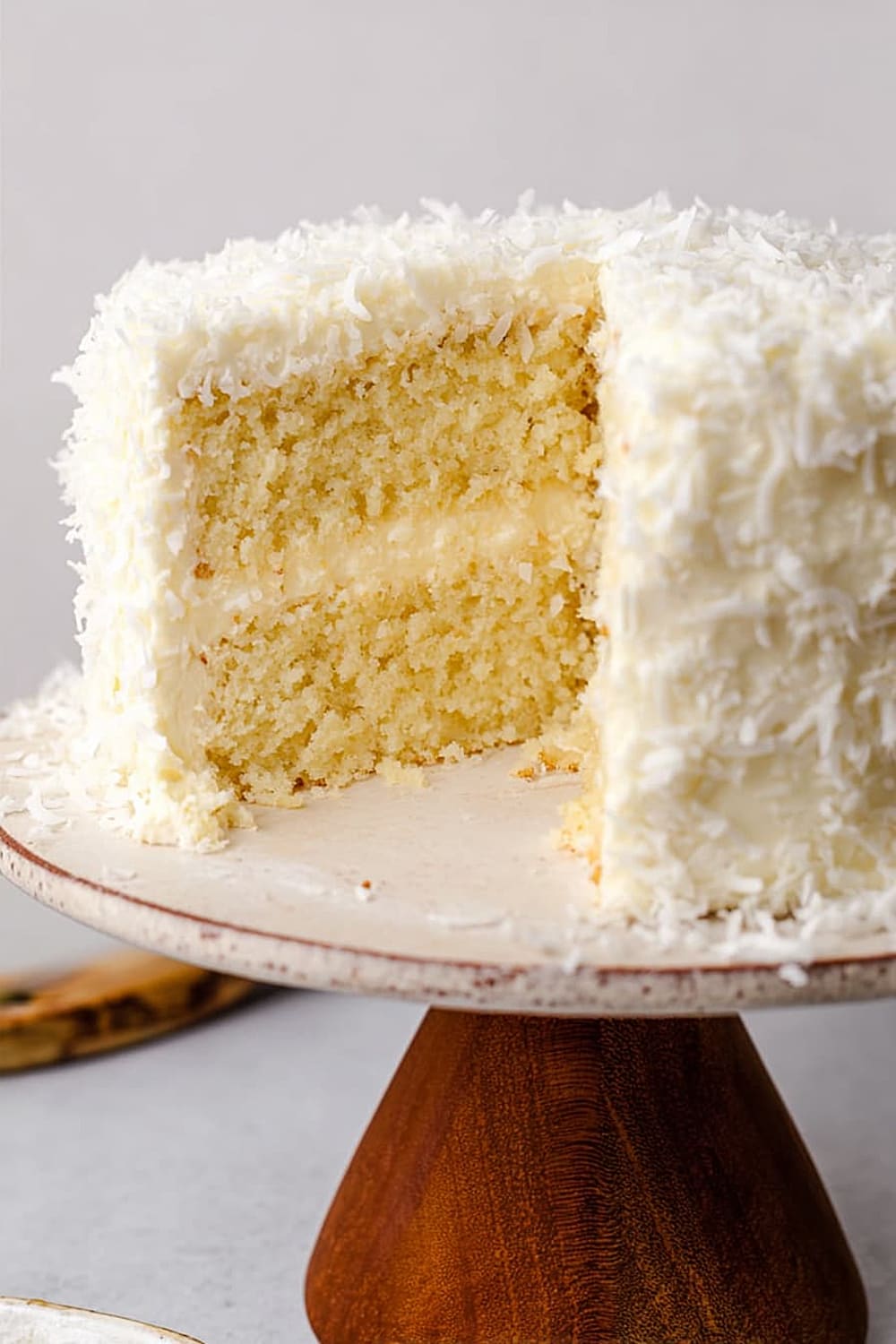
Professional Techniques:
The key to professional-level results lies in temperature control – all ingredients should be at true room temperature, which means 68-72°F (20-22°C). Test butter by pressing it with your finger; it should give easily without being melty. For the smoothest frosting, sift the powdered sugar before adding it to prevent lumps. When assembling layers, use a turntable if available and apply frosting in thin layers, building up gradually for the smoothest finish.
Common Mistake Prevention:
Overmixing is the biggest culprit in tough cakes – once you add flour, mix just until combined. Uneven layers happen when you don’t divide batter equally; use a kitchen scale to weigh each pan for identical results. Cracked frosting occurs when the cake is too warm when you frost it – patience pays off here. Dense texture usually means your butter wasn’t properly creamed or your leavening agents are old – replace baking powder every 6 months.
Storage and Make-Ahead Strategies:
Unfrosted cake layers can be wrapped tightly and frozen for up to 3 months – they actually slice and frost more easily when slightly frozen. Frosted cake keeps at room temperature for 2 days or refrigerated for 1 week. For best texture, bring refrigerated cake to room temperature 30 minutes before serving. The frosting can be made 3 days ahead and stored covered in the refrigerator – just re-whip briefly before using.
Scaling and Presentation:
To double the recipe, use the same temperatures but increase baking time by 3-5 minutes. For cupcakes, fill liners ⅔ full and bake 18-22 minutes. Professional presentation tip: Use an offset spatula dipped in warm water to create perfectly smooth frosting surfaces. Coconut decoration adheres best when pressed gently into fresh frosting – don’t wait until it crusts over.